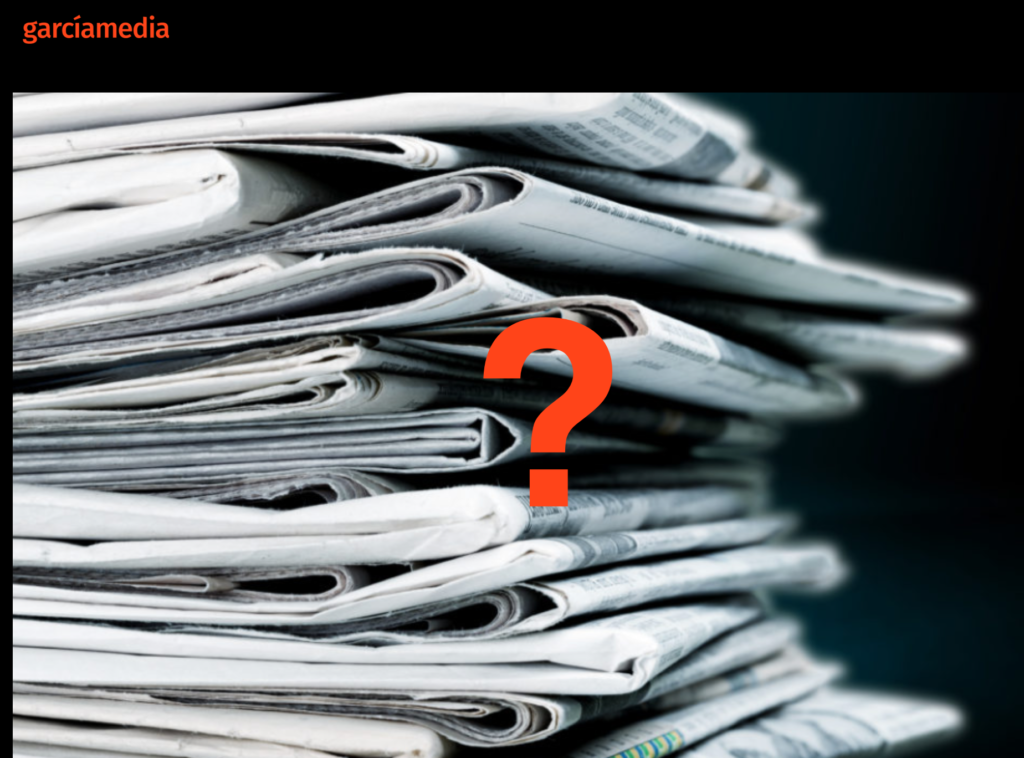
The course I teach at Columbia University’s School of Journalism is titled Multiplatform Design & Storytelling. This is my 11th year taking students through a journey in which we identify the story as the most important element, but then instructs them on strategies for differentiating how stories are consumed via various platforms. One size does not fit all.
Today, content and format are top considerations for the journalist.
The term “Multiplatform” is a reminder that in today’s journalistic ecosystem we prepare content for various platforms: mobile, digital, print. The 16-week course I teach includes only one week for a discussion of print and its role in a mobile-first world.
I begin with this assignment in which students must write a short statement about their relationship with print, whatever that is.
“I want your honest answer,” I told my students last week in preparation of their assigned task. “I have not seen a single copy of a printed magazine, newspaper or book on your desks the entire semester, so that is already a tell tale for me. But, I am willing to listen with an open mind: do you read a newspaper or magazine in print? Do you have printed books around your house that you read? When was the last time that you came in contact with that magic combination that is ink on paper?
Here is what they said…..
My students are all working toward their Masters in Journalism degree, which they will receive upon graduation in May 2022. Average age is about 23 years old.
“Where did I put that newspaper or magazine”…..”
Whatever information I consume, whether that be news, education, or entertainment, I check them on digital platforms. I do, occasionally, try to pick up a physical book or newspaper here and there just to change my scenery. For me, having a physical print product felt inconvenient and I would sometimes lose track of where I put them last. –James
“I don’t subscribe to any print newspapers or magazines…In the future maybe I will…”
I do not read print, I read the news on digital platforms like my phone or laptop because it’s more
convenient for me. Reading the news on my phone is easy for me when I want to read another
article, I can simply search the headline on my phone or go back to the home site instead of
flipping through papers. I don’t subscribe to any print newspapers or magazines…In the future
maybe I will, for aesthetic reasons only though.–Kaye
“My relationship with print is very sentimental…”
I also used to use magazines to make collages, and when I first started reading them, I tried to create my own out of construction paper and drawings. My relationship with print is very sentimental; I don’t really have any experience with the medium on the other side of things, but I have been a pretty invested consumer.–Amira W.
“Physical books, magazines and papers nice, but I don’t buy any.”
Most of my news consumption comes from three specific sources – television, online (seen through my laptop), or through social media – links that my friends and family send through Whatsapp, Twitter, and even Instagram. I would say that I rarely read print. Even with the Sunday New York Times, the off chance I do get it, I will usually head straight for the crossword while perhaps perusing through the stories that happen to catch my attention. Nevertheless, I do find myself at times reading magazines. Especially when I know I will have a lot of spare time when internet will not be readily available, such as on a long flight or lounging by the pool or beach, I do find myself picking up a magazine – usually the New Yorker or The Economist. ……..Although I do like reading physical books, magazines, and papers, I don’t find myself subscribing or intentionally buying these forms of media outright. –Alex
“It is about nostalgia for me….”
I have a very nostalgic relationship with print. For the most part, I consume all of my news and media on my phone, every single morning. However, I still like the idea of reading long form pieces on print. I have a subcription to Vogue and other print magazines that I get every month and I enjoy it. Again, I think because there is a nostalgic sentiment there. I like to flip through the pages. I still prefer to read book in print rather than on e-book format. But I only do this with magazines and regular books. I don’t buy newspapers in print. The only time I would ever see them would be at school in my art class where we would use newspaper to make different projects. I use magazines in a similar way after a long time. Instead of just throwing them away, I’ll donate them or use them for my own diy projects, inspiartion boards, etc. I also like print magazines because I like to appreciate the photos in person. Screens hurt my eyes recently so having a print format also really helps.–Maria
“I grew up with many papers around the breakfast table…..but I don’t buy print today”
I have been reading print newspapers and magazines ever since I was able to hold and go through them even though I could not read yet. At home in Antwerp, every morning several newspapers are waiting to be read at the breakfast table. …….I still love print. In New York City I pass by the magazine store Casa Magazines and enjoy going through all the pint editions from fashion to design and news. I must admit I don’t buy print when I’m alone and have no subscriptions here, so 99% of what I read is digital for the moment. To finish this little section on print, I still love to buy magazines at the airport as well to read on the plane and at my holiday destination.–June
“My everyday life does not feature print……”
When I think about my everyday life, I notice that print is not consistently a part of my life. I will pick up a book for class or in my free time every once in a while, but all of my news is on my phone, laptop, or iPad. Every morning I wake up and look up the news on Twitter and Instagram, which will direct me to new sites with even more information about that situation I read about in a short post on social media. ……….My everyday life does not feature print, but I believe that print is still essential and valuable today.
“As a journalist, I want to write for digital publications.”
My personal connection to print isn’t strong. I grew up with newspaper delivery service; my grandmother loved to clip coupons and read the sports scores. In my hometown of Baltimore, we also use newspapers as crab paper. Standing in lines at the grocery store as a kid, I would browse through issues of Teen Vogue or Seventeen Magazine, now I access everything digitally. I have subscriptions to publications like the NYT, one of the few newspapers I read, but my favorite magazines are digital only – so, most of what I read has never been in print. I do think print is a necessity for accessibility. Despite being in the digital age, some people cannot consume their news online and depend on print to know what’s happening in the world. Furthermore, print doesn’t appeal to the Gen-Z audience. As a journalist, I want to write for digital publications.–Kaniya
“My friend keeps printed books around as part of her interior design….”
” Sometimes ink and paper bring you a sense of coziness, and one of my friends told me that she loves to see how books are piled up on her shelves. Books are part of her interior (design), which shows her personality and uniqueness………Since college, I have picked e-books because they are cheaper, lighter, and environmentally friendly. Primarily, there were many affordable textbooks online. Students prefer to buy textbooks online for some elective classes because they know they will never read them in the future. E-books are also a wise choice to carry during vacation and on trains. Paper books and e-books should co-exist because they can compensate for their shortcomings.–Akane
“There is comfort in this joint experience (of reading newspaper with family.”
To me, newspapers feel nostalgic, from the smell of the printed ink to the touch of the newsprint paper. I grew up living with my grandparents, so a typical morning routine involved drinking a cup of chai, reading the newspapers, and chatting about the most interesting articles in the paper. There is comfort in this joint experience of starting our days together over these newspapers, where everything from the Bollywood gossip, cartoons, and breaking news – all lived in one physi- cal space.–Ahaanaa
“I still often turn to print media to relax…”
Digital versions of media add an exciting element because of the potential for incorporating vivid visual elements and interactive components. The access to thousands of titles with a push of a button also make for a convenience factor that is unmatched. However, I still often turn to print media to relax because it does not quite bring the same serenity as being unplugged. Notifications pop in interrupting and pulling you out of the world you are trying to immerse yourself in. The convenience comes at the cost of a true sense of peace. Without that moment of pause, there is no chance to slip one’s daily routine and escape into adventure.–Isabella
“I still find myself drawn to the design of magazines and newspapers even though I tend to not pay too much attention to the content inside….”
When I was four years old, I would go to the store just to buy magazines. It didn’t matter the store, sometimes it was Petco, sometimes Home Depot. At that point I couldn’t read so I was drawn in by the design of the magazine. As I got older, I continued to buy magazines every time I went to the store. I was later introduced to newspapers, and I loved being able to get information that way. When the internet started to become popular, I found it easier and more accessible to get my news from Yahoo news as I checked my email. I still find myself drawn to the design of magazines and newspapers even though I tend to not pay too much attention to the content inside, as I mostly get my news from digital platforms. –Marlene
“I don’t read in print for news, only periodicals.”–Peter
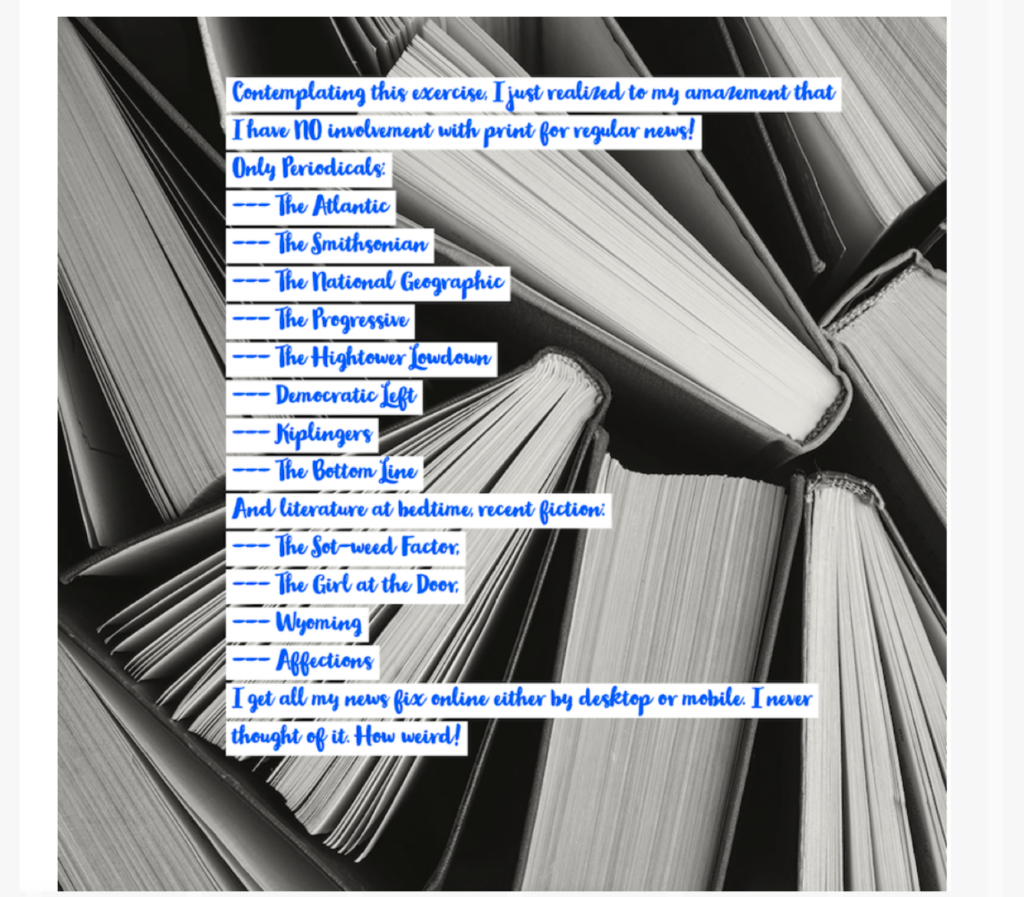
“Print has made a comeback for me as I grew older..”
Print did make a strong comeback for me when I grew older, after consuming endless digital contents. I miss
the feeling of going into my studying room, picking up a book and reading it. Nowadays, I started going to
bookstores more often to pick up a book for the next couple weeks and I would read whenever I am
commuting to work or to school. There is just this magical thing about print that digital can never replace.
The texture of the paper, the unique scent of each book/ newspaper shall never be replaced by digital.–Alison
The takeaways
My Columbia University students’ answers to the question about their relationship with print are not surprising . Those answers confirm what I have sensed during the past 11 years teaching graduate journalism students:
- While these are among the most informed and news oriented students I ever taught, print is not part of their arsenal of tools to get information.
- There is a sense of nostalgia—the romance of print— in how they refer to newspapers and magazines. Sort of like “my grandfather used to read a daily newspaper with his coffee in the morning.”
- If they are going to come in contact with ink on paper it may be more via a magazine or a book than a newspaper.
- And, no, not one would pay for a print newspaper subscription.
The good news about this: Because they do not think in terms of print, they are more open to crafting stories for mobile and digital consumption. In a few years, these young students will be editors for whom the term legacy will probably mean the composition of a mobile story.
Our mobile storytelling workshops now available remotely
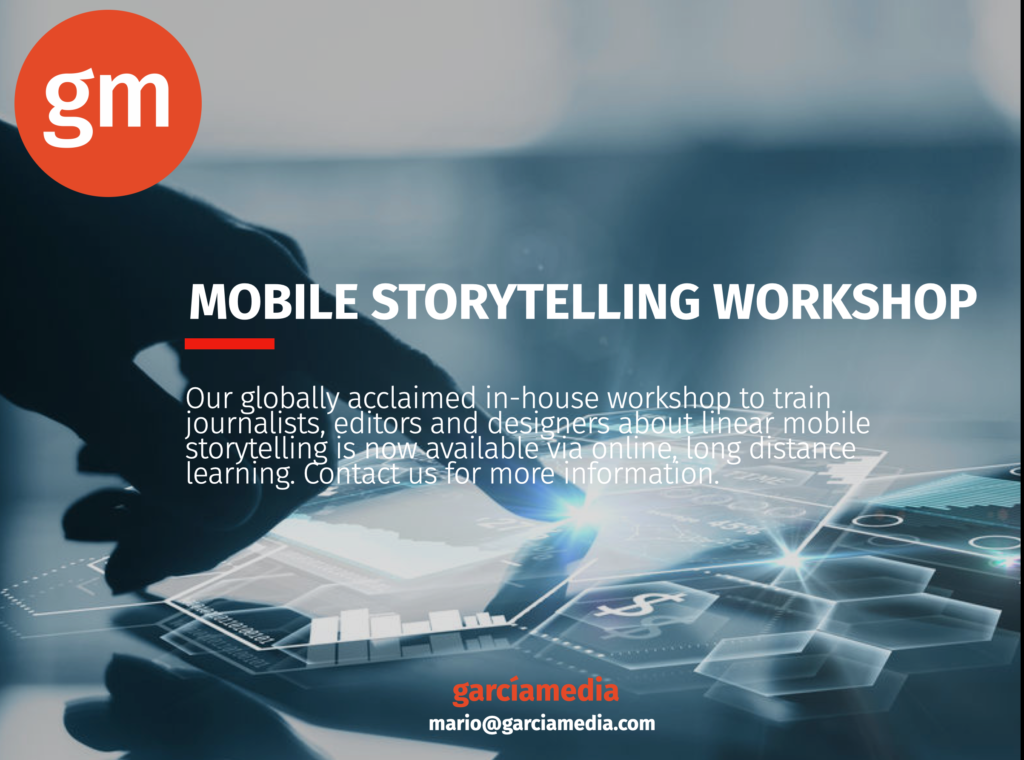
Professors: get your review version of The Story on time for summer, fall classes
As an academic, I know the importance of having the right tools to advance our students, especially on the important subject of mobile storytelling. Please drop me an email if you would like to sample The Story in its digital edition: mario@garciamedia.com
Start writing or type / to choose a block
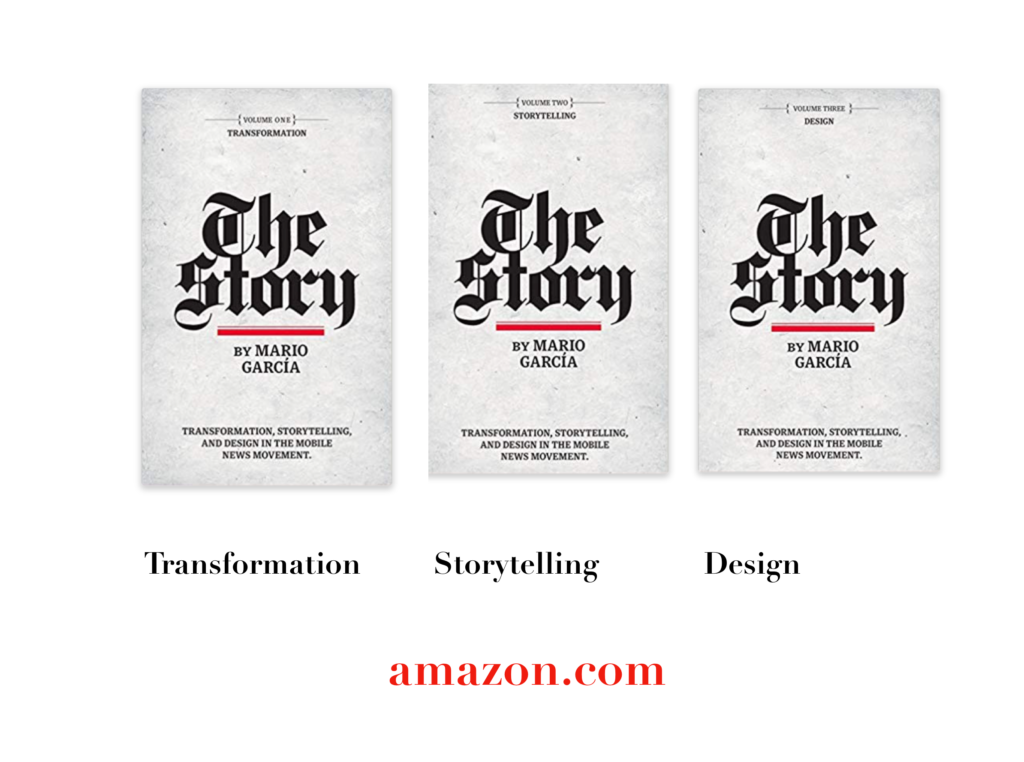
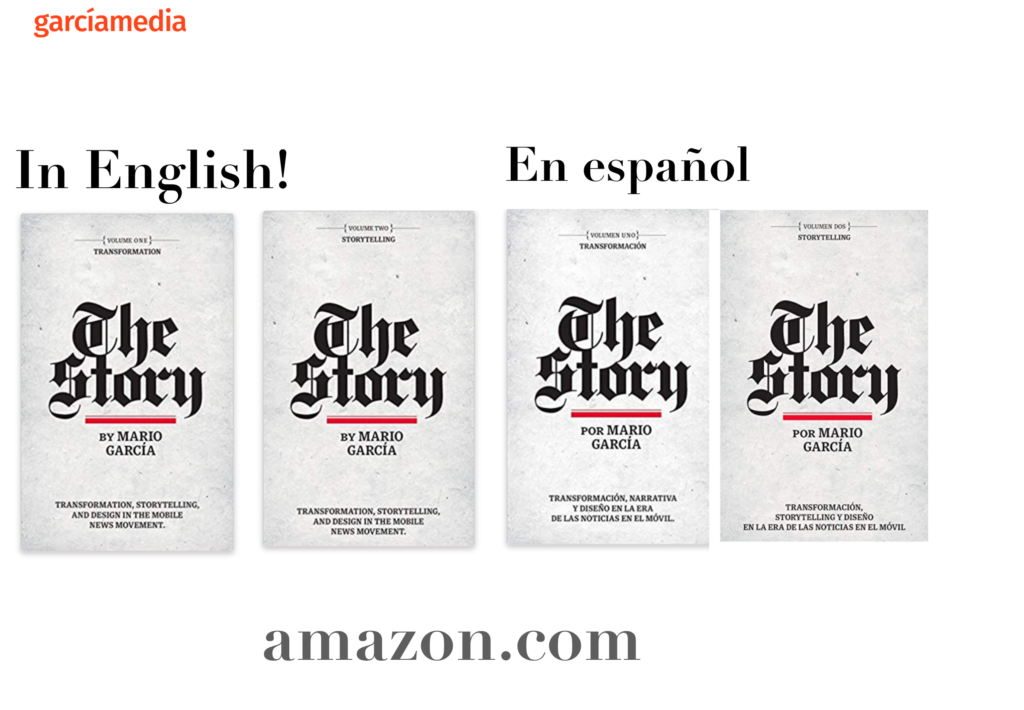
The full trilogy of The Story now available–3 books to guide you through a mobile first strategy. Whether you’re a reporter, editor, designer, publisher, corporate communicator, The Story is for you! https://amazon
TheMarioBlog post # 3347